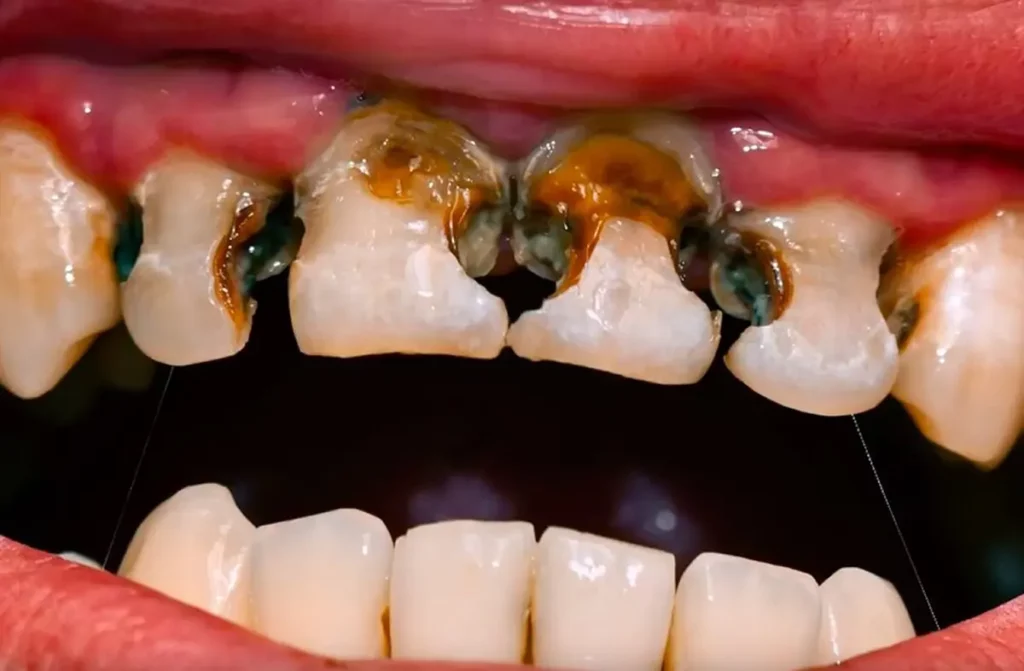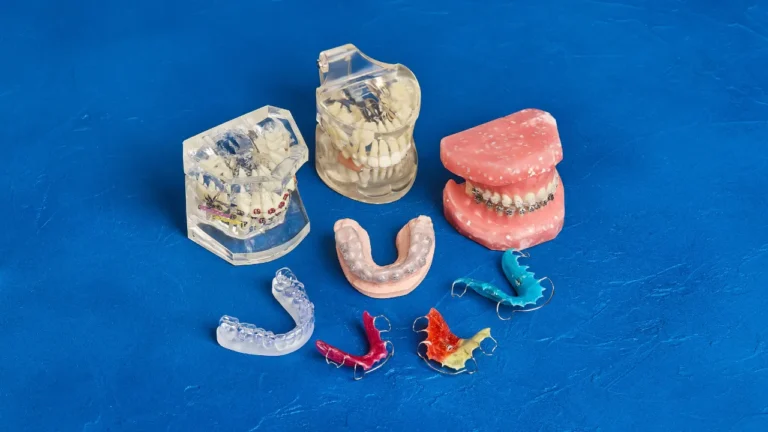Here are some of the most common early signs of tooth decay:
- Sensitivity to hot/cold temperatures
- Pain/discomfort when biting/chewing
- Visible pits/holes
- Stains/discoloration
- Rough or sticky texture
Signs of tooth decay explained
Sensitivity to hot, cold, or sweet foods and drinks
Sensitivity to hot, cold, or sweet foods and drinks is a common sign of early tooth decay.
This sensitivity occurs when the enamel of your teeth has been weakened, making it more sensitive to temperature changes and sweet or acidic substances.
The sensitivity is often a result of the bacteria in your mouth breaking down the enamel of your teeth, causing it to become thin and brittle.
Over time, this can lead to the formation of cavities, which can be painful and make your teeth more sensitive to temperature changes and sweet or acidic substances.
If you are experiencing sensitivity to hot, cold, or sweet foods and drinks, it is important to address the issue as soon as possible.
Ignoring the problem can lead to more serious dental issues, such as the development of cavities, which can cause pain and increase the risk of tooth loss.
Visible holes or pits in teeth
Visible holes or pits in your teeth are another common sign of early tooth decay. These holes or pits can range in size from small to large, and they may be visible as dark or white spots on your teeth.
The visible holes or pits are often the result of bacteria in your mouth breaking down the enamel of your teeth and forming cavities.
The cavities can weaken the structure of your teeth, making it easier for bacteria to penetrate and cause further damage.
If you notice visible holes or pits in your teeth, it is important to seek dental treatment as soon as possible. Ignoring the issue can lead to more serious dental problems, such as tooth decay, which can cause pain, discomfort, and tooth loss.
Pain or discomfort when biting or chewing
Pain or discomfort when biting or chewing is another common sign of early tooth decay.
This pain can range from mild to severe, and it may be accompanied by other symptoms, such as sensitivity to hot, cold, or sweet foods and drinks.
The pain or discomfort when biting or chewing is often the result of the bacteria in your mouth breaking down the enamel of your teeth and forming cavities.
The cavities can cause pain and discomfort when you bite or chew, as well as increase the risk of tooth loss.
If you are experiencing pain or discomfort when biting or chewing, it is important to seek dental treatment as soon as possible.
Ignoring the issue can lead to more serious dental problems, such as tooth decay, which can cause pain, discomfort, and tooth loss.
Discoloration or brown spots on teeth
Discoloration or brown spots on your teeth are another common sign of early tooth decay. These spots can range in size from small to large, and they may be visible as dark or brown spots on your teeth.
The discoloration or brown spots are often the result of bacteria in your mouth breaking down the enamel of your teeth and forming cavities. The cavities can weaken the structure of your teeth, making it easier for bacteria to penetrate and cause further damage.
If you notice discoloration or brown spots on your teeth, it is important to address the issue as soon as possible. These spots can be a sign of early tooth decay, and if left untreated, they can become more serious and potentially cause further damage to your teeth and gums.
If you are experiencing discoloration or brown spots on your teeth, it is recommended that you schedule a dental appointment as soon as possible.
Your dentist will examine your teeth, gums, and mouth to determine the cause of the discoloration and will recommend appropriate treatment to help prevent further damage and keep your smile healthy and bright.
Don’t ignore the signs of early tooth decay – prompt attention can help you avoid more serious problems down the road.
Rough or sticky texture on certain teeth
If you have a rough or sticky texture on certain teeth, it could be a sign of early tooth decay.
This texture is usually caused by plaque buildup on the surface of the teeth, which can lead to the development of cavities.
Tooth decay is caused by the buildup of bacteria in the mouth, which can produce harmful acids that erode the enamel on your teeth.
This erosion can result in the formation of cavities, which can cause rough or sticky textures on the teeth. The longer the plaque buildup continues, the more serious the tooth decay will become.
Addressing the issue of rough or sticky textures on your teeth is important for maintaining good oral health. If left untreated, tooth decay can lead to more serious problems such as infections, tooth loss, and even gum disease.
To prevent and treat tooth decay, it is important to maintain good oral hygiene practices, such as brushing your teeth regularly and flossing daily, and to have regular dental check-ups.
If you notice a rough or sticky texture on certain teeth, it is recommended that you schedule a dental appointment as soon as possible to receive a proper diagnosis and treatment plan.
Early detection and treatment of tooth decay can help you avoid more serious problems in the future.
Causes of tooth decay
Tooth decay is caused by the buildup of plaque, a sticky film of bacteria that forms on teeth.
Plaque produces acids that can damage the enamel (the hard, outer layer of teeth) and eventually cause a cavity.
The following factors can increase the risk of tooth decay:
- Poor oral hygiene: When you don’t brush and floss regularly, plaque can build up and increase your risk of decay.
- Diet: Consuming sugary or acidic foods and drinks can also contribute to plaque formation and increase your risk of decay.
- Dry mouth: Saliva helps to neutralize acids and wash away food particles that can contribute to plaque formation. Certain medical conditions, medications, and aging can cause dry mouth and increase your risk of decay.
- Lack of dental care: Regular dental cleanings and check-ups can help to remove plaque and detect any early signs of decay.
- Poor nutrition: A diet that is lacking in essential vitamins and minerals can weaken the enamel and make teeth more susceptible to decay.
- Genetics: Some people may be more susceptible to tooth decay due to genetic factors, such as a lack of saliva production or a higher risk of gum disease.
- Medical conditions: Certain medical conditions, such as diabetes and HIV/AIDS, can affect the health of the gums and increase the risk of decay.
- Aging: As you get older, your risk of decay increases due to changes in the mouth and a decreased ability to maintain good oral hygiene.
Prevention and treatment
- Regular dental check-ups: Regular dental check-ups are an important part of preventing and treating tooth decay. During a dental check-up, your dentist will examine your teeth, gums, and mouth to check for any signs of tooth decay or other dental problems. They will also clean your teeth and remove any plaque or tartar that may have accumulated. Regular dental check-ups can help to prevent tooth decay by catching any problems early and allowing your dentist to treat them before they become more serious.
- Good oral hygiene practices: Good oral hygiene practices are another important aspect of preventing and treating tooth decay. This includes brushing your teeth twice a day with a fluoride toothpaste, flossing daily, and using mouthwash to remove any bacteria that may have accumulated in your mouth. It is also important to limit your consumption of sugary and acidic foods and drinks, as these can increase the risk of tooth decay.
- Brush Twice a Day with Fluoride Toothpaste: Brushing twice a day with fluoride toothpaste is the best way to prevent tooth decay. Fluoride helps to strengthen the enamel and prevent cavities.
- Floss Daily: Flossing daily removes plaque and food particles from between the teeth and along the gumline, where toothbrushes can’t reach.
Possible treatments
If you are experiencing tooth decay, your dentist may recommend a variety of treatments, depending on the severity of the problem.
These may include filling the cavity, crowns or caps to cover the damaged tooth, or a root canal to remove any infected or damaged tissue.
In more severe cases, your dentist may recommend a tooth extraction or a dental implant to replace the damaged or missing tooth.
It is important to work closely with your dentist to determine the best treatment plan for your individual needs and to ensure that your teeth and gums are healthy and functioning properly.
Risk factors for tooth decay
There are several factors that increase your risk of developing tooth decay, including:
- Poor oral hygiene
- Frequent consumption of sugary or acidic foods and drinks
- Dry mouth
- Certain medical conditions
- Genetics
Take away
Tooth decay is a common dental problem that can lead to more serious issues if left untreated.
By knowing the early signs of tooth decay and taking steps to prevent it, you can maintain good oral health and avoid the need for more extensive and costly dental procedures.
If you experience any of the early signs of tooth decay, it’s important to see a dentist as soon as possible to get the treatment you need.





